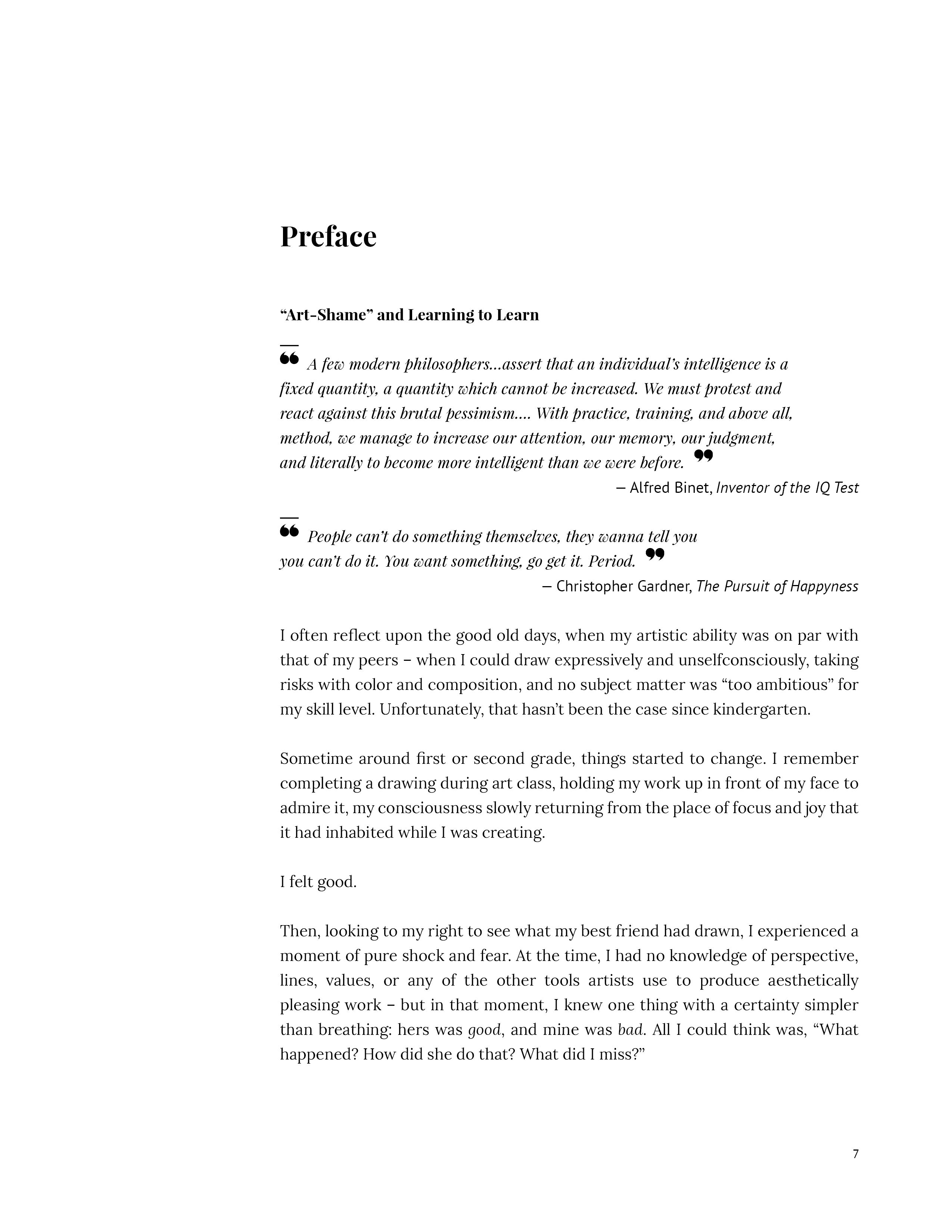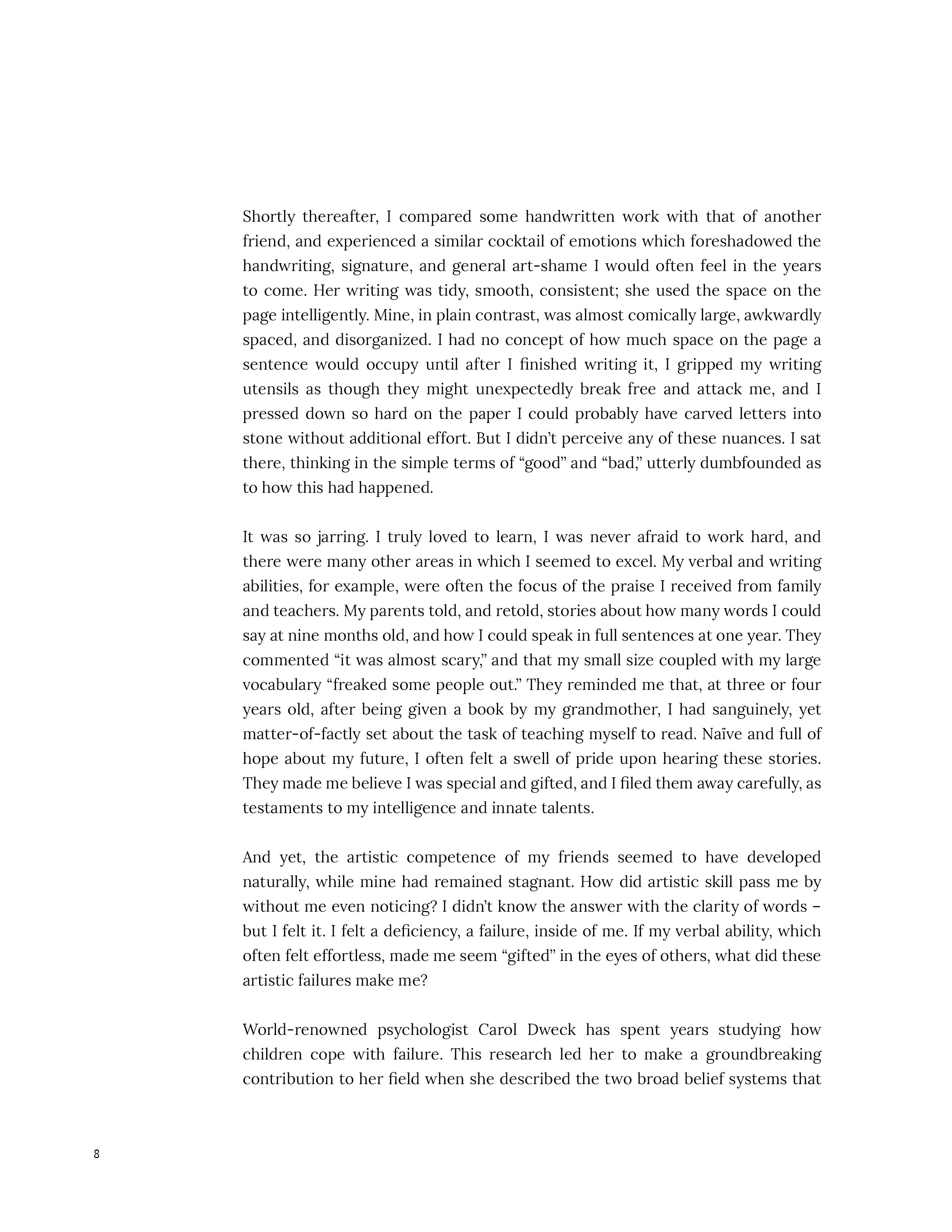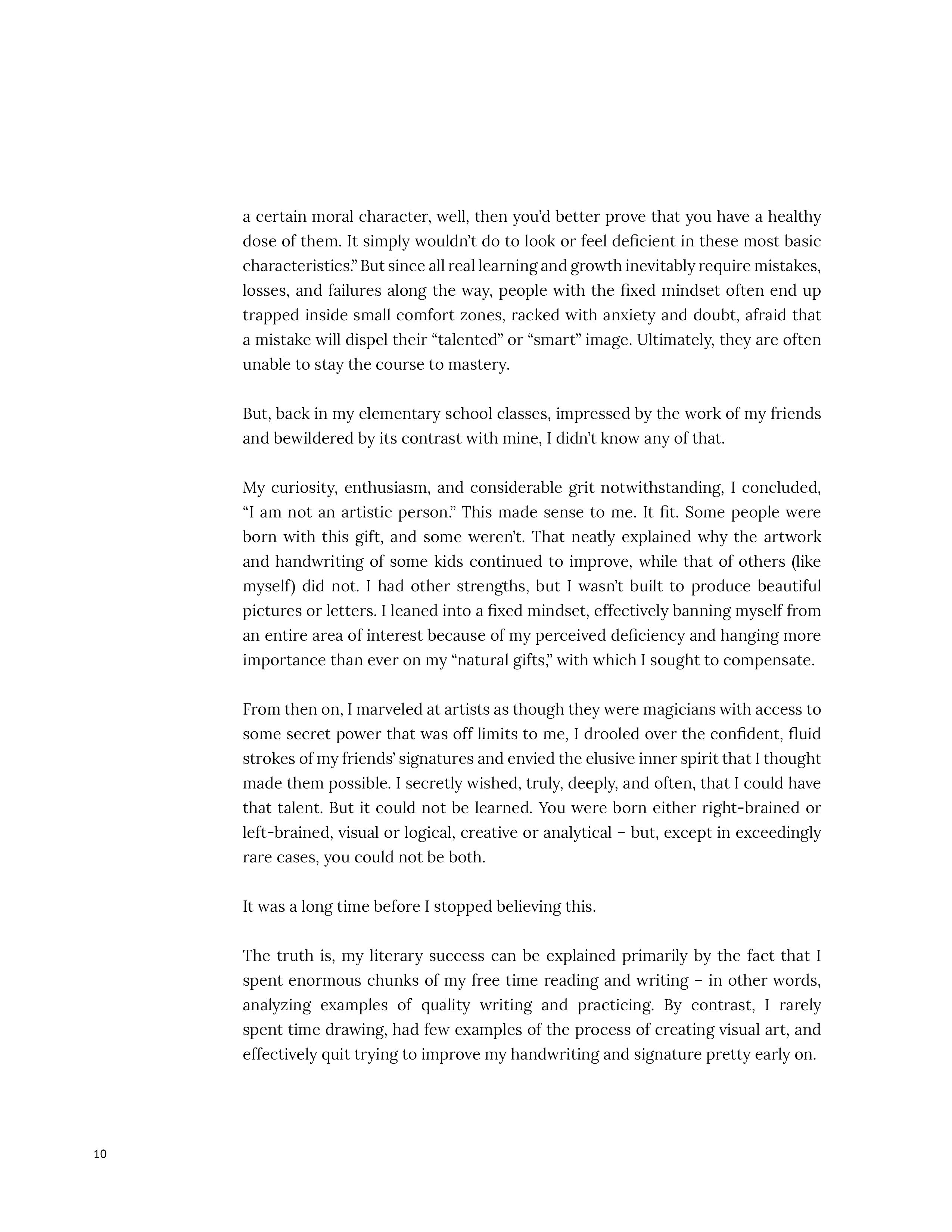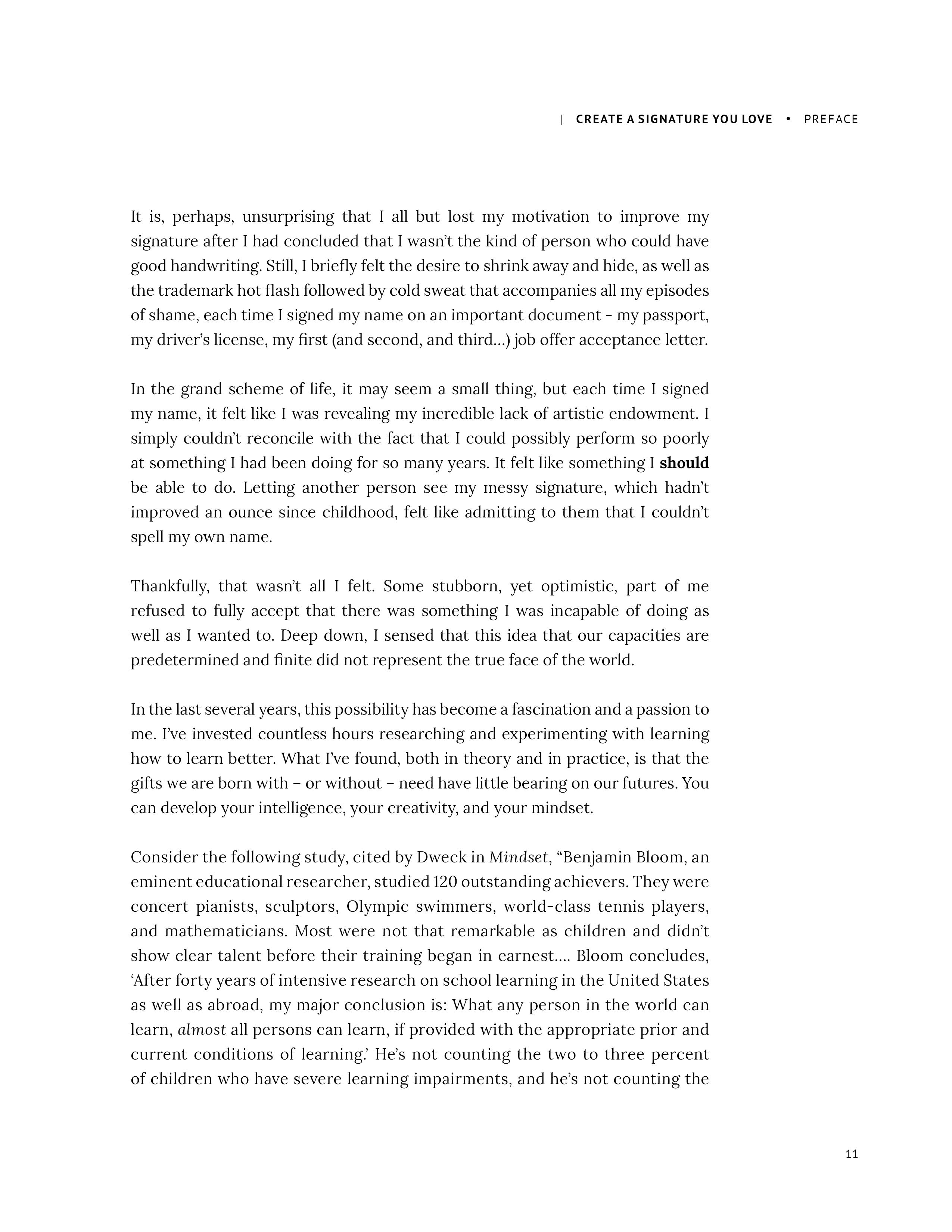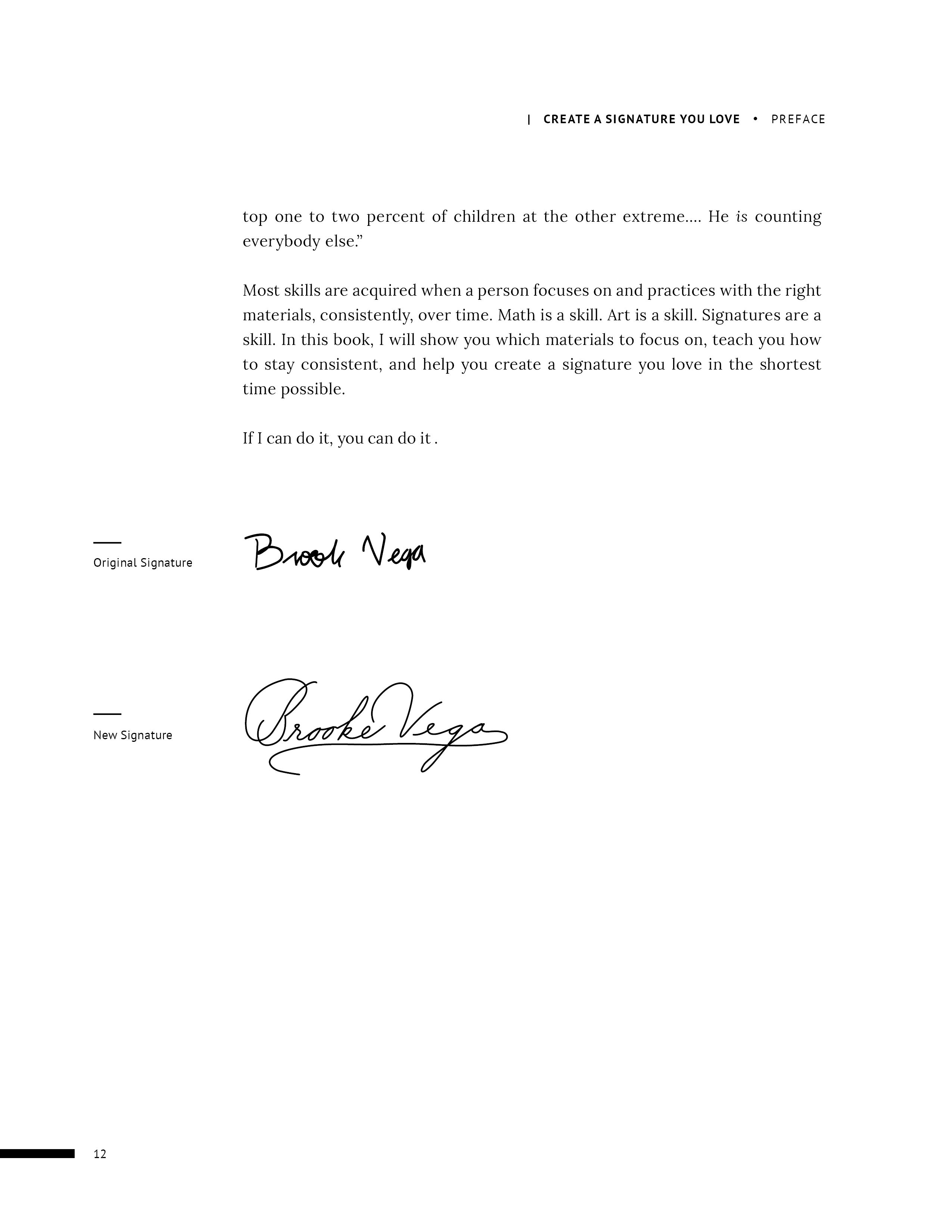“Art-Shame” and Learning to Learn
“A few modern philosophers…assert that an individual’s intelligence is a fixed quantity, a quantity which cannot be increased. We must protest and react against this brutal pessimism…. With practice, training, and above all, method, we manage to increase our attention, our memory, our judgment, and literally to become more intelligent than we were before.” Alfred Binet, Inventor of the IQ Test
“People can’t do something themselves, they wanna tell you you can’t do it. You want something, go get it. Period.” Christopher Gardner, The Pursuit of Happyness
I often reflect upon the good old days, when my artistic ability was on par with that of my peers – when I could draw expressively and unselfconsciously, taking risks with color and composition, and no subject matter was “too ambitious” for my skill level. Unfortunately, that hasn’t been the case since kindergarten.
Sometime around first or second grade, things started to change. I remember completing a drawing during art class, holding my work up in front of my face to admire it, my consciousness slowly returning from the place of focus and joy that it had inhabited while I was creating.
I felt good.
Then, looking to my right to see what my best friend had drawn, I experienced a moment of pure shock and fear. At the time, I had no knowledge of perspective, lines, values, or any of the other tools artists use to produce aesthetically pleasing work – but in that moment, I knew one thing with a certainty simpler than breathing: hers was good, and mine was bad. All I could think was, “What happened? How did she do that? What did I miss?”
Shortly thereafter, I compared some handwritten work with that of another friend, and experienced a similar cocktail of emotions which foreshadowed the handwriting, signature, and general art-shame I would often feel in the years to come. Her writing was tidy, smooth, consistent; she used the space on the page intelligently. Mine, in plain contrast, was almost comically large, awkwardly spaced, and disorganized. I had no concept of how much space on the page a sentence would occupy until after I finished writing it, I gripped my writing utensils as though they might unexpectedly break free and attack me, and I pressed down so hard on the paper I could probably have carved letters into stone without additional effort. But I didn’t perceive any of these nuances. I sat there, thinking in the simple terms of “good” and “bad,” utterly dumbfounded as to how this had happened.
It was so jarring. I truly loved to learn, I was never afraid to work hard, and there were many other areas in which I seemed to excel. My verbal and writing abilities, for example, were often the focus of the praise I received from family and teachers. My parents told, and retold, stories about how many words I could say at nine months old, and how I could speak in full sentences at one year. They commented "it was almost scary," and that my small size coupled with my large vocabulary "freaked some people out." They reminded me that, at three or four years old, after being given a book by my grandmother, I had sanguinely, yet matter-of-factly set about the task of teaching myself to read. Naïve and full of hope about my future, I often felt a swell of pride upon hearing these stories. They made me believe I was special and gifted, and I filed them away carefully, as testaments to my intelligence and innate talents.
And yet, the artistic competence of my friends seemed to have developed naturally, while mine had remained stagnant. How did artistic skill pass me by without me even noticing? I didn’t know the answer with the clarity of words – but I felt it. I felt a deficiency, a failure, inside of me. If my verbal ability, which often felt effortless, made me seem “gifted” in the eyes of others, what did these artistic failures make me?
World-renowned psychologist Carol Dweck has spent years studying how children cope with failure. This research led her to make a groundbreaking contribution to her field when she described the two broad belief systems that people have about intelligence and ability. She calls these belief systems the “fixed mindset” and the “growth mindset.”
A person with a fixed mindset views learning (either in general or in relation to specific tasks) as being tied to innate and immutable ability. Results in learning are seen as a function of raw talent; i.e. a fixed mindset child with a poor grade in math class might say “I’m not good at math” or even, tragically, “I’m not smart enough.” If the same child experiences success in writing or sports, he might say “I’m really creative” or “I’ve always been athletic.” Whether the child is experiencing success or failure, ability is described as a feature of who the child is, and the outcome is explained as an inevitable expression of that feature. The emphasis in this mindset is on fixed, inborn human characteristics or capacities.
By contrast, a person with a growth mindset essentially believes that intelligence and talent can be developed. Learning, therefore, is understood as a long-term process where results are primarily a function of effort expended, time spent, quality of instruction or materials, etc. A child with a growth mindset, experiencing the same setbacks and achievements from the examples above, might respond to them by saying “I need to study harder for math class,” and “I’m getting good at writing/sports because I have a great teacher/coach and I practice all the time.” The emphasis is on behaviors.
Dweck has found that these mindsets are instrumental factors in whether people succeed in reaching their potential, and in whether they have a positive relationship to learning. While the growth mindset has been linked to enjoyment of learning, resilience in the face of setbacks, and mastery, the fixed mindset has been linked to decreased self-confidence, brittle resolve, and learned helplessness.
Why?
In the face of failure, people with the fixed mindset tend to feel not only that they have failed in this instance, but that they are failures. Even in success, “fixed mindsetters” link their self-worth to their results. As Dweck puts it in her important book, Mindset: The New Psychology of Success, “Believing that your qualities are carved in stone… creates an urgency to prove yourself over and over. If you only have a certain amount of intelligence, a certain personality, and a certain moral character, well, then you’d better prove that you have a healthy dose of them. It simply wouldn’t do to look or feel deficient in these most basic characteristics.” But since all real learning and growth inevitably require mistakes, losses, and failures along the way, people with the fixed mindset often end up trapped inside small comfort zones, racked with anxiety and doubt, afraid that a mistake will dispel their “talented” or “smart” image. Ultimately, they are often unable to stay the course to mastery.
But, back in my elementary school classes, impressed by the work of my friends and bewildered by its contrast with mine, I didn’t know any of that.
My curiosity, enthusiasm, and considerable grit notwithstanding, I concluded, “I am not an artistic person.” This made sense to me. It fit. Some people were born with this gift, and some weren’t. That neatly explained why the artwork and handwriting of some kids continued to improve, while that of others (like myself) did not. I had other strengths, but I wasn’t built to produce beautiful pictures or letters. I leaned into a fixed mindset, effectively banning myself from an entire area of interest because of my perceived deficiency and hanging more importance than ever on my “natural gifts,” with which I sought to compensate.
From then on, I marveled at artists as though they were magicians with access to some secret power that was off limits to me, I drooled over the confident, fluid strokes of my friends’ signatures and envied the elusive inner spirit that I thought made them possible. I secretly wished, truly, deeply, and often, that I could have that talent. But it could not be learned. You were born either right-brained or left-brained, visual or logical, creative or analytical – but, except in exceedingly rare cases, you could not be both.
It was a long time before I stopped believing this.
The truth is, my literary success can be explained primarily by the fact that I spent enormous chunks of my free time reading and writing – in other words, analyzing examples of quality writing and practicing. By contrast, I rarely spent time drawing, had few examples of the process of creating visual art, and effectively quit trying to improve my handwriting and signature pretty early on.
It is, perhaps, unsurprising that I all but lost my motivation to improve my signature after I had concluded that I wasn’t the kind of person who could have good handwriting. Still, I briefly felt the desire to shrink away and hide, as well as the trademark hot flash followed by cold sweat that accompanies all my episodes of shame, each time I signed my name on an important document - my passport, my driver’s license, my first (and second, and third…) job offer acceptance letter.
In the grand scheme of life, it may seem a small thing, but each time I signed my name, it felt like I was revealing my incredible lack of artistic endowment. I simply couldn’t reconcile with the fact that I could possibly perform so poorly at something I had been doing for so many years. It felt like something I should be able to do. Letting another person see my messy signature, which hadn’t improved an ounce since childhood, felt like admitting to them that I couldn’t spell my own name.
Thankfully, that wasn’t all I felt. Some stubborn, yet optimistic, part of me refused to fully accept that there was something I was incapable of doing as well as I wanted to. Deep down, I sensed that this idea that our capacities are predetermined and finite did not represent the true face of the world.
In the last several years, this possibility has become a fascination and a passion to me. I’ve invested countless hours researching and experimenting with learning how to learn better. What I’ve found, both in theory and in practice, is that the gifts we are born with – or without – need have little bearing on our futures. You can develop your intelligence, your creativity, and your mindset.
Consider the following study, cited by Dweck in Mindset, “Benjamin Bloom, an eminent educational researcher, studied 120 outstanding achievers. They were concert pianists, sculptors, Olympic swimmers, world-class tennis players, and mathematicians. Most were not that remarkable as children and didn’t show clear talent before their training began in earnest…. Bloom concludes, ‘After forty years of intensive research on school learning in the United States as well as abroad, my major conclusion is: What any person in the world can learn, almost all persons can learn, if provided with the appropriate prior and current conditions of learning.’ He’s not counting the two to three percent of children who have severe learning impairments, and he’s not counting the top one to two percent of children at the other extreme…. He is counting everybody else.”
Most skills are acquired when a person focuses on and practices with the right materials, consistently, over time. Math is a skill. Art is a skill. Signatures are a skill. In this book, I will show you which materials to focus on, teach you how to stay consistent, and help you create a signature you love in the shortest time possible.
If I can do it, you can do it.
